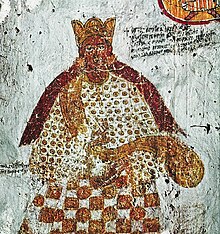Moses Georgios (Ancient Greek: Μώσες Γεωργίου) was ruler of the Nubian kingdom of Makuria. During his reign it is believed that the crown of Alodia was also under the control of Makuria.[1] He is mostly known for his conflict with Saladin.
| Moses Georgios Μώσες Γεωργίου | |
|---|---|
| King of Makuria and Alodia | |
 Mural from Faras Cathedral depicting King Moses Georgios | |
| Reign | 1155–1190 |
| Predecessor | Georgios IV |
| Born | Dongola, Nubia |
| Religion | Coptic Orthodox Christianity |
Life and reign
editIn 1171, the Ayyubids overthrew the Fatimid Caliphate, whose capital was Cairo.[2] This brought Makuria and the Ayyubids into conflict with each other. The following year,[3] a Makurian army pillaged Aswan and advanced even further north. It is not clear if this campaign was intended to aid the Fatimids or was merely a raid[2] exploiting the unstable situation in Egypt,[4] although the latter seems more likely, as the Makurians apparently soon withdrew.[5]
To deal with the Nubians, Saladin sent his brother Turan-Shah. The latter conquered Qasr Ibrim in January 1173,[6] reportedly sacking it, taking many prisoners, pillaging the church, and converting it into a mosque.[7] Afterward, he sent an emissary to King Moses Georgios,[8] intending to answer a previously requested peace treaty with a pair of arrows.[9]
Moses Georgios was a man confident in his ability to resist the Ayyubid army, stamping with hot iron a cross on the emissary's hand.[8] Turan-Shah withdrew from Nubia but left a detachment of Kurdish troops in Qasr Ibrim, which would raid Lower Nubia for the next two years. Archaeological evidence links them with the destruction of the Faras Cathedral,[10] the Central Church of Abdallah Nirqi,[11] and Debeira West.[citation needed]
In 1175, a Nubian army finally arrived to confront the invaders at Adindan. Before battle, however, the Kurdish commander drowned while crossing the Nile, resulting in the retreat of Saladin's troops out of Nubia.[10] Afterwards, there was peace for another 100 years in which Georgios had independence over Nubia while Aswan was reoccupied by the Ayyubids and a garrison of Kurdish soldiers was stationed there.[2]
References
edit- ^ Lajtar 2009, pp. 93–94.
- ^ a b c Adams 1977, p. 456.
- ^ Welsby 2002, p. 75.
- ^ Plumley 1983, p. 162.
- ^ Ruffini 2012, pp. 249–250.
- ^ Werner 2013, p. 113.
- ^ Plumley 1983, pp. 162–163.
- ^ a b Ruffini 2012, p. 248.
- ^ Welsby 2002, p. 76.
- ^ a b Plumley 1983, p. 164.
- ^ Welsby 2002, p. 124.
Sources
edit- Adams, William Y. (1977). Nubia: Corridor to Africa. Princeton: Princeton University. ISBN 978-0-7139-0579-3.
- Lajtar, Adam (2009). "Varia Nubica XII-XIX" (PDF). The Journal of Juristic Papyrology (in German). XXXIX: 83–119. ISSN 0075-4277.
- Plumley, J. Martin (1983). "Qasr Ibrim and Islam". Études et Travaux. XII: 157–170.
- Ruffini, Giovanni R. (2012). Medieval Nubia. A Social and Economic History. Oxford University.
- Welsby, Derek (2002). The Medieval Kingdoms of Nubia. Pagans, Christians and Muslims along the Middle Nile. The British Museum. ISBN 0714119474.
- Werner, Roland (2013). Das Christentum in Nubien. Geschichte und Gestalt einer afrikanischen Kirche. Lit.